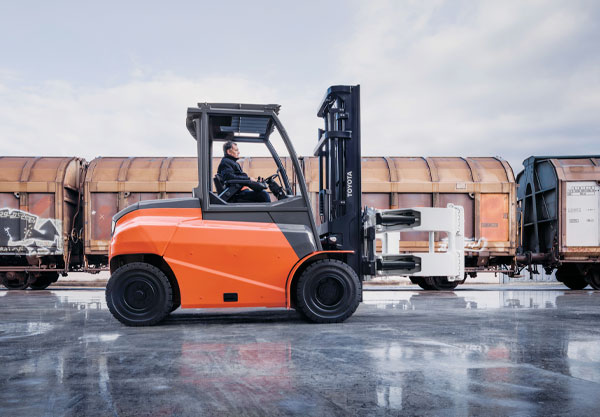With various state implementation plans in place for zero-emission and climate control goals in the U.S. ramping up for 2030, we are starting to see many businesses converting their fleet of forklifts from internal combustion (IC) to electric. Currently representing nearly 65% of the market, going electric is a trend that has occurred over the last decade and continues to grow.
According to Jacob Ratekin, Director of Sales Strategy at Shoppa’s Material Handling (Shoppa’s), “Electrification isn’t coming; it’s already here. Across virtually all economic sectors – from industrial to consumer – electrification has proven itself as a viable alternative and is gaining momentum by the minute. Advancements in motive power technologies have allowed us to help more and more customers realize the financial – and environmental – benefits of ‘going electric’ with their lift truck fleets.”
Preston Shoppa, Field Service Manager at Shoppa’s added that “based on the way the material handling market seems to be heading, the warehouse and distribution centers of the future will have autonomous forklifts, lithium-ion batteries, shuttle systems, and many other forms of automation. The days of swapping out a propane tank or filling up a forklift with gasoline or diesel will be a thing of the past in many operations. Shoppa also noted that there are some important factors to consider when making the decision to switch to electric. “Due to rising environmental criteria, the impact on total cost of ownership, and efficiency advantages it is easy to make the case for electric forklifts, under the right conditions. However, there are also some reasons to hold off on making the switch.”
At Shoppa’s, we understand the value of a highly informed decision and want to provide the full insight needed to make the right decision for your operation. Here are some of the advantages and disadvantages to consider when deciding between IC and electric forklifts.
Advantages of Going Electric
Due to the emergence of things like fast-charging capabilities, higher-voltage outputs, and new and improved battery, pump, and motor technologies, electric forklifts are gaining traction. According to Shoppa, this shift is really helping companies to justify the switch to electric forklifts. Also, in many cases the cost savings and efficiency gains alone make switching to electric well worth it. Here are some of the core advantages:
-
- Lower cost of ownership – While electric forklifts can cost more upfront than IC models, they offer a lower total cost of ownership by saving you money on fuel, maintenance, and repairs over the life of the truck. In fact, the average cost for a 3K lb. electric lift might be thousands of dollars more expensive at point-of-purchase, but the return on investment after five years makes the electric forklift, on average, about $5,000 per truck/per shift less expensive. It is also estimated that it is 75% less expensive to operate with electricity vs. propane fuel, and there are multiple charging options (e.g., conventional, opportunity, fast, lithium). There are also many tax incentives and grants available to offset costs.
- Improved warehouse & environment – Electric forklifts offer a more pleasant operating experience, enhancing operator comfort and reduced fatigue through fewer vibrations, a quieter ride, less heat, and zero emissions. There is also the benefit of not having to worry about storage of liquid propane, diesel, or gas on site and/or arranging delivery services. Additionally, the 100% reduction in carbon emissions provides for a cleaner, healthier working environment and supports “green” initiatives.
- Reduced maintenance & repairs – With fewer moving parts, no spark plugs, and no required oil changes or tune-ups, electric forklifts require less maintenance and repair than IC forklifts, cutting costs and keeping your fleet on the floor for superior productivity.
Disadvantages of Going Electric
As tempting as this sounds, there are some potential obstacles to consider if you want to go electric.
Electric forklifts:
-
-
- Require more storage space – Storing electric forklifts also tends to be a bit more complex than for IC forklifts. For example, they can require up to 200 square feet of storage space for the forklift, the battery (or batteries), and battery charging stations.
- Are more difficult to refuel – It can take significantly longer to replace a battery on an electric forklift than to refuel a forklift with an internal combustion engine. In addition, because batteries must often charge for 8 hours and then cool down for 8 hours in between uses, you may need one battery per shift. This requirement can add significant cost to purchasing and owning an electric forklift.
- Have some additional limitations – Voltage requirements to support charging may be an issue with older facilities, resulting in additional infrastructure spending to upfit existing facilities. Additionally, while technology and options are evolving, users that operate lift trucks outside – especially in adverse weather conditions and/or rough terrain – typically will not recognize the same versatility that traditional IC forklifts offer.
-
Making the Call
Regardless of which type of forklift you choose to move forward with, when you can balance factors such as price, environmental friendliness, and convenience, you will be better positioned to select the best forklift for your needs. Shoppa’s Material Handling can help to audit your operation and provide you with the appropriate recommendation for your business. If you are ready to make the switch, Viking Power, Shoppa’s Material Handling’s energy solutions provider, is here to meet your energy needs with new and used batteries and chargers, power source rentals, 24/7 on-call service, and preventative maintenance plans to help protect your equipment investment. To learn more, contact a Shoppa’s Material Handling expert today.


